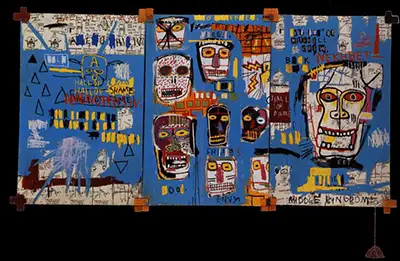Items are lined up in a tidier fashion than is normal for the chaos of Basquiat, and this allows us to more easily dissect the piece. There are nearly a dozen faces staring at us here, with a larger one holding more importance on the very right hand side of the overall piece. There are three panels to this work in total, which most likely were individual planks of wood which are loosely connected together around the edges, as shown in the photograph. To the left hand side we find a number of patterns of simple abstract shapes, with lettering then placed on the edges of each of the panels. Basquiat chose to term this artwork as the Mitchell Crew, which clearly refers to the collective name for this group of individuals who no doubt are the focus of this piece.
The Abstract Expressionists from the US in the second half of the 20th century would tend to work quickly in order to avoid the evaluation of their work on a conscious level. They wanted to connect with the depths of their mind in a natural manner, avoiding self-censorship as much as possible. Basquiat would have a good idea of what he wanted to convey prior to commencing each painting but would then allow his mind to take over in the process of actually delivering this content on to the paper, card or canvas. As he became more ambitious, the canvases could grow in size, allowing him to work in life size, or perhaps even larger with some of his iconic portraits. This then created a bigger impact for those fortunate enough to see his work in person.
The artist produced hundreds of artworks across his short career, working tirelessly and vigorously as a means to self-expression and almost an approach to self-therapy as he sought to deal with his own issues. Ultimately, these problems would contribute to his early passing, but not until he had already produced some truly breaktaking murals, the likes of which included Tuxedo, In Italian and Dustheads. Today his career is held in a truly high regard and he has been entirely accepted into the mainstream, although it is unlikely that he would have felt comfortable with that. He worked on the fringes of the art world with an alternative background to most, but the quality of his work would eventually bring considerable fame and a celebrity-like status that remains just as strong today.


